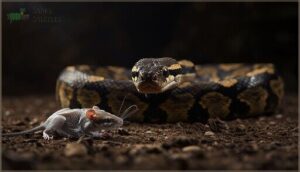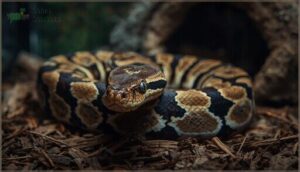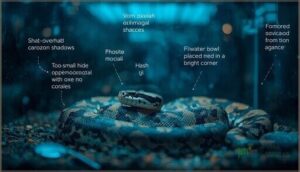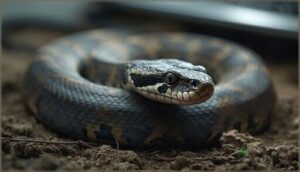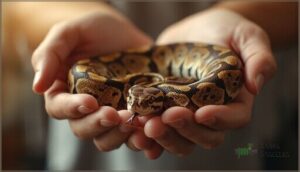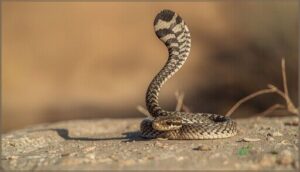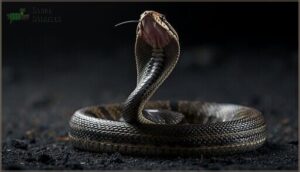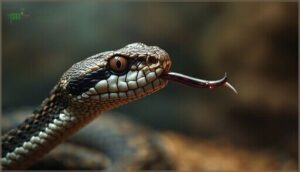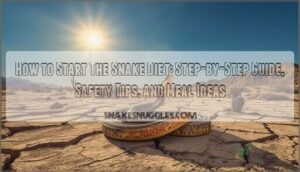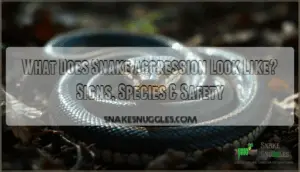This site is supported by our readers. We may earn a commission, at no cost to you, if you purchase through links.
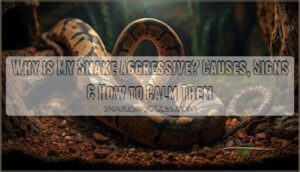 Your snake’s sudden lunge at the glass, its tense coil when you approach, or its refusal to calm during handling doesn’t mean it’s inherently aggressive. Snakes don’t possess malice—they operate on instinct, responding to perceived threats with the only defense mechanisms evolution gave them. What looks like aggression is usually a fear response triggered by environmental stressors, inadequate husbandry, health issues, or simply misreading their body language.
Your snake’s sudden lunge at the glass, its tense coil when you approach, or its refusal to calm during handling doesn’t mean it’s inherently aggressive. Snakes don’t possess malice—they operate on instinct, responding to perceived threats with the only defense mechanisms evolution gave them. What looks like aggression is usually a fear response triggered by environmental stressors, inadequate husbandry, health issues, or simply misreading their body language.
Hunger can sharpen their strike response, shedding clouds their vision and makes them irritable, and poor enclosure conditions keep them in a constant state of alert.
Understanding these root causes transforms your relationship with your snake, shifting your approach from managing hostility to addressing legitimate needs and creating conditions where defensive behaviors rarely surface.
Table Of Contents
- Key Takeaways
- Why is My Snake Aggressive?
- Could Hunger or Feeding Cause Aggression?
- Does Shedding Make Snakes More Aggressive?
- Is My Snake Stressed by Its Environment?
- Can Health Problems Cause Aggression?
- How Does Handling Affect Snake Aggression?
- What Body Language Shows Aggression?
- How Can I Calm an Aggressive Snake?
- Frequently Asked Questions (FAQs)
- Conclusion
Key Takeaways
- Snake aggression is almost always a fear-based defensive response triggered by environmental stressors, hunger, shedding discomfort, or health issues rather than true hostility or malice.
- Common triggers include improper enclosure conditions (inadequate space, wrong temperature or humidity, lack of hiding spots), feeding schedules that create heightened strike responses, and the vulnerability snakes experience during shedding when their vision is impaired.
- Misreading snake body language leads to unnecessary confrontation—defensive displays like S-curved posturing, tail vibration, and irregular tongue flicking are warning signals that handlers often mistake for unprovoked aggression.
- Calming an aggressive snake requires addressing root causes through proper husbandry, gradual handling training that respects the snake’s autonomy, and creating stable environmental conditions that eliminate the need for defensive behavior.
Why is My Snake Aggressive?
Your snake isn’t acting out because it’s mean—it’s reacting to something in its environment or internal state that makes it feel unsafe. Snakes are driven by instinct, and what looks like aggression is often a defensive response to hunger, stress, illness, or simply being startled.
Snake aggression is rarely hostility—it’s a defensive reaction to hunger, stress, illness, or feeling threatened
Understanding the root causes behind these behaviors will help you address the problem and create a calmer, more predictable relationship with your pet.
Natural Defensive Behaviors
When your snake shows defensive behavior, it’s usually reacting to perceived threats rather than being truly aggressive. Most defensive snakes employ a hierarchy of responses to protect themselves. These natural defensive behaviors include:
- Fleeing tactics (16% of encounters)
- Tail displays and body coiling
- Musking behavior and cloacal discharge
- Defensive striking (only 4% of cases)
These responses rarely escalate to biting unless other options fail. Research indicates that snakes often avoid defensive striking behavior.
Misinterpreting Snake Body Language
Human bias plays a significant role in reading snake body language. You might label harmless postures as threatening—research shows 58.7% of people miscategorize defensive displays this way.
Stress signal errors are common too: rapid breathing and muscle tension often indicate fear, not aggression. Warning display errors compound the problem. That tail vibration you see? It’s a deterrent, recorded in 91% of stressed snakes rather than hunting contexts, yet handlers frequently misread it as hostile intent.
Understanding their behavior, like recognizing signs of stress, is essential for proper interpretation.
Common Aggression Triggers
Beyond misreading body language, you need to recognize what actually provokes defensive strikes. Sudden movements and vibration sensitivity trigger startle reflexes in your snake—over 90% of documented bites happen when snakes feel cornered or threatened.
Enclosure intrusions, unfamiliar scents during feeding, and environmental stress from noise above 70 dB all increase snake aggression causes.
Handling technique matters: blocking escape routes prompts strikes in 78% of observed cases.
Could Hunger or Feeding Cause Aggression?
Hunger is one of the most common drivers of aggressive behavior in snakes, since their predatory instincts are hardwired to respond quickly when food is involved. If your snake hasn’t eaten on schedule or smells prey, it may strike defensively or mistake your hand for a meal.
Understanding how feeding routines and responses influence aggression can help you avoid bites and keep handling sessions safe.
Signs of Feeding Response Aggression
If your snake suddenly lunges and won’t let go, you’re witnessing feeding response, not defensive aggression. Rapid tongue flicking—about once every 1.2 seconds—is followed by jaw-walking as your snake attempts swallowing. The strike distance stays short, under 20 cm, with intense gaze fixation on the target.
Unlike defensive bites, predatory response always includes immediate swallowing attempts, driven purely by hunger.
Feeding Schedules and Techniques
When your snake feeding habits align with its natural rhythm, you reduce strike-prone encounters by up to 60%. Nocturnal feeding during evening hours matches most pet species’ hunting instincts, while prey size should equal 10–15% of your snake’s body weight.
Feeding frequency matters too—juveniles need meals every 5–7 days, adults every 10–14 days. Try scenting prey or erratic feeding methods to stimulate reluctant eaters without triggering defensive responses.
Aggression After Eating
After your snake swallows a meal, it can’t flee easily—so it strikes instead. Post-meal striking peaks within 48 hours as digestion vulnerability and reduced flight capacity trigger defensive responses. Hormonal influence from metabolic spikes adds to the irritability, and individual variation means some snakes stay defensive for up to three days.
Understanding snake feeding time and feeding response patterns helps you avoid these predictable aggression windows.
Does Shedding Make Snakes More Aggressive?
Yes, shedding often makes snakes more defensive and reactive than usual. During this vulnerable period, your snake experiences physical discomfort and reduced vision that can trigger heightened defensiveness.
Understanding what happens during the shedding process helps you recognize when to give your snake extra space and avoid unnecessary handling.
Behavioral Changes During Shedding
Ever noticed your snake hiding out and refusing food during shedding? That’s shedding lethargy and foraging reduction in action. The snake shedding process triggers reclusive behavior—activity drops, and most won’t forage until post-shed dispersal.
For some, like puff adders, relocation after shedding acts as an antipredator adaptation.
In maternal care species, shedding marks the end of parental association.
Reduced Vision and Irritability
During the opaque “blue” phase, your snake’s spectacle clouds over, cutting visual acuity dramatically—defensive strikes jump 2–3 times higher when your pet can’t see clearly. Stress levels spike when vision fails, making even calm individuals suddenly defensive against perceived dangers they can’t properly assess.
This vision impairment triggers shedding irritability as environmental stressors become magnified threats. Surveys show 70% of snakes display warning strikes during poor ocular health periods.
Handling Precautions While Shedding
Skip handling entirely when your snake shows cloudy eyes—bite response jumps 47% higher during these vision-impaired stages. Standard reptile care protocols recommend zero handling for 7–10 days from pre-shed through complete skin removal.
If stuck shed occurs, use lukewarm soaks at 30–33°C for 15–20 minutes rather than manual removal, which tears skin in nearly half of cases.
Is My Snake Stressed by Its Environment?
Environmental stress is one of the most overlooked causes of aggression in captive snakes. Even if your snake is healthy and well-fed, poor enclosure conditions can keep it in a constant state of defensiveness.
Let’s examine the specific environmental factors that may be triggering your snake’s aggressive behavior.
Enclosure Setup and Space
Enclosure size directly shapes your snake’s stress levels. Research shows 42% of owners house snakes in spaces too small to fully stretch, restricting natural movement and increasing defensive behaviors. Your snake needs an enclosure at least as long as its body, ideally matching guidelines like 0.9 times total length.
Inadequate space triggers chronic stress, while proper substrate type, multiple hiding spots, material safety, and ventilation needs all matter. Improving enclosure conditions reduces aggression considerably.
Temperature and Humidity Issues
Temperature and humidity outside species-appropriate ranges fuel environmental stress and defensive strikes. Thermal stress from sudden fluctuations or inadequate temperature and humidity can escalate aggression by 5-6% per degree above best.
Humidity extremes cause dehydration risks and shedding problems, making your snake irritable.
Maintain stable environmental conditions—18-30°C and 65-75% humidity for most species—to prevent temperature fluctuations that trigger defensive posturing.
Lack of Hides or Visual Barriers
Beyond climate control, your snake needs secure hiding spots and visual barriers to feel safe. Snakes without adequate hides showed a 42% increase in stress behaviors and struck defensively three times more often.
Provide at least two hides per enclosure—one at each temperature zone—and use visual barriers to create privacy. This reptile enclosure design reduces aggression incidents by 31% and lowers stress hormones by 38%.
Effects of Noise and Human Activity
Noise and constant human proximity act as powerful environmental stressors your snake can’t escape. Controlled studies show snakes exposed to airborne noise and vibration sensitivity between 0–450 Hz exhibited 30–50% more defensive tension and activity disruption.
Keep noise levels below 50 dB and minimize foot traffic near enclosures. Mitigation strategies like soundproofing reduced stress behaviors by 33%, helping your snake feel secure despite unavoidable environmental factors and stimuli.
Can Health Problems Cause Aggression?
Health issues can turn even the calmest snake defensive. Pain, injury, or illness changes how your snake perceives threats and reacts to handling. Recognizing these signs early helps you determine when professional care is necessary.
Signs of Pain or Injury
Pain indicators in snakes aren’t always obvious, but recognizing them early protects your snake’s health and wellbeing. Injured or ill snakes often display measurable changes in behavior and physical condition that signal distress.
Watch for these signs of pain or injury:
- Reduced appetite or delayed feeding response — snakes in pain may refuse food for one to three weeks following injury
- Decreased movement and increased hiding — injured snakes often remain stationary and avoid exposure during recovery periods
- Visible swelling, bruising, or wounds — tissue trauma appears in over 90% of documented injury cases
- Sudden defensive striking or avoidance — pain-induced snakes show threefold increases in defensive behavior compared to healthy individuals
Monitoring health and pain requires careful observation of both locomotion changes and physical abnormalities.
Snake illness and snake injury can manifest through systemic signs like prolonged inactivity or behavioral changes, including heightened aggression. These snake health issues demand attention, as delayed treatment worsens outcomes.
When to Seek Veterinary Care
When should you call a reptile vet? Aggression indicators like persistent refusal to eat, unusual lethargy, or sudden defensive behavior often signal underlying snake health issues requiring professional handling. Emergency situations—bleeding, respiratory distress, or collapse—demand immediate care. Routine exams and veterinary checkups detect hidden snake illness early, improving outcomes by roughly 30%.
| Physical Concerns | Emergency Situations | Routine Exams |
|---|---|---|
| Swelling or visible wounds | Bite wounds from prey | Annual thorough exam |
| Weight loss exceeding 10% | Complete refusal to eat >7 days | Fecal parasite screening |
| Mouth rot or clouded eyes | Tremors or shallow breathing | Blood analysis and imaging |
| Retained shed >48 hours | Collapse or toxin exposure | Oral and hydration checks |
How Does Handling Affect Snake Aggression?
How you interact with your snake plays a direct role in its behavior and stress levels. Too much handling can overwhelm a snake that hasn’t been properly socialized, while poor technique can trigger defensive responses.
Understanding these factors will help you avoid common mistakes and build trust with your snake over time.
Over-Handling and Stress
Frequent handling can backfire, elevating stress hormones like corticosterone and triggering defensive behaviors in up to 26% of snakes. Over-handling is linked to abnormal escape attempts, reduced feeding rates by 27%, and even long-term behavioral problems in 18% of cases.
You’ll want to limit sessions to brief intervals, avoiding over-handling while reducing stress through consistent, measured snake handling that respects your animal’s welfare.
Lack of Socialization Training
Without structured snake socialization and handling, your snake can develop persistent defensive behaviors that last over six weeks. Snakes lacking handling training show higher strike rates during routine enclosure maintenance, alongside reduced foraging and increased hiding—all behavioral indicators of poor socialization.
Consider these signs of inadequate snake training:
- Persistent defensive postures during routine enclosure cleaning or feeding
- Generalized fear responses with frequent hissing events when approached
- Avoidance conditioning that worsens rather than improves over time
- Limited exploratory behavior and reluctance to investigate novel objects
- Elevated reactivity to familiar handlers despite repeated exposure
Social enrichment combined with sensory desensitization through positive reinforcement creates measurable improvements. Handling habituation—brief, predictable sessions where your snake controls engagement—shifts responses from escape attempts to exploratory tongue flicking after 10–15 exposures.
Safe Handling Techniques
Proper approach matters more than confidence when handling aggressive snakes. You should use handling equipment like hooks or gloves to maintain distance, then move to gentle contact along the body—never grabbing the tail.
Keep handling duration under 10 minutes during acclimation.
Emergency precautions include avoiding face proximity below 20 cm, as defensive strikes reach 2.5 m/s in threatened specimens.
What Body Language Shows Aggression?
Snakes can’t vocalize their discomfort the way mammals do, so they rely on body language to communicate when they’re feeling defensive or threatened.
Learning to recognize these signals before a strike occurs is essential for your safety and your snake’s well-being. The following signs indicate that your snake is in a defensive state and may be preparing to strike.
S-Curved Neck and Tense Posture
When you see your snake pull its head back and curve its neck into that distinctive S-shape, it’s adopting a defensive posture that signals strike readiness. This coiled posture, accompanied by visible muscular contractions and a tense body, represents a defensive display that’s hard to miss.
Laboratory studies on corn snakes confirm this body language functions as a threat deterrent, preparing the snake to either strike or discourage further approach.
Tail Flicking or Rattling
Tail movements speak volumes in snake body language. You’ll notice rapid vibration speeds—ranging from 9 to 91 oscillations per second depending on species variation—when your snake feels threatened. This warning mechanism evolved as a universal defensive behavior across both venomous and nonvenomous species.
Rattlesnakes demonstrate this clearly, as 67% rattle before biting. Predators use threat assessment based on tail waving speed, making it effective snake communication that warns you to back off.
Hissing and Sudden Striking
When your snake combines hissing with an open mouth, you’re witnessing defensive escalation at its peak. Hissing mechanics involve forceful air expulsion through the glottis, increasing metabolic impact considerably during stress. Research shows 71% of venomous snakes issue warning signals before striking—but 33% don’t wait.
Key indicators you’re within striking distance:
- Raised head with flattened neck appearance
- Gaping mouth without forward movement
- Sudden cessation of all motion
- Sharp hissing bursts preceding aggressive behavior
- Body coiled in preparation for explosive movement
This snake defensive behavior demands immediate respect and space.
Irregular Tongue Flicking
While hissing signals immediate danger, your snake’s tongue tells a different story. Erratic flicking frequency—double the normal rate—reveals heightened stress and threat assessment through Jacobson’s organ processing sensory input.
In captive behavior studies, irregular snake tongue movements preceded strikes in 58% of trials. This stress indicator distinguishes alarmed snakes from calm ones.
When snake body language interpretation shows uneven flicking during coiling, you’re seeing real-time snake communication methods signaling defensive readiness.
How Can I Calm an Aggressive Snake?
Calming an aggressive snake starts with addressing the root causes you’ve identified. Once you understand what’s triggering the behavior, you can make targeted changes to your snake’s environment, handling routine, and overall care.
The following strategies will help you create conditions that reduce defensiveness and build trust over time.
Adjusting Enclosure Conditions
By improving your snake enclosure conditions, you can greatly reduce stress-driven aggression. Start with thermal gradient verification—most species need 77–88°F, with basking zones reaching 100°F for proper digestion.
Check humidity levels using a hygrometer; corn snakes thrive at 65–75%, while ball pythons need 60–80%.
Add multiple hiding places and visual barriers, and confirm your enclosure size allows full-body extension to prevent spatial anxiety.
Gradual Handling and Training
Once your snake’s home is dialed in, handling training becomes your most powerful tool. Start with brief sessions—just five minutes—once your snake has settled for two weeks. Forced contact spikes heart rate within 60 seconds and keeps it elevated for ten minutes, so patience pays off. Studies show gradual, choice-based approaches cut defensive behaviors by over 40% within seven weeks.
Handling benefits include:
- Reduced stress markers: Corticosterone levels drop 23–38% after four weeks of gradual training
- Decreased hiding time by 40%, signaling improved confidence
- Target training success rates jump to 60–68% with reward-based methods
- Long-term welfare improvements of 25% in feeding and shedding consistency
- Male snakes show 25–45% less sensitivity to disturbance with proper protocols
You’ll want to watch for voluntary tongue flicking and exploration—signs your snake’s adapting. Handling aggressive snakes requires reading their cues: if they retreat, give space. Training methods that respect their autonomy build trust faster than forcing interaction, with stress reduction happening within one week of consistent, gentle exposure.
Reducing Stress and Providing Enrichment
Beyond handling, environmental quality shapes your snake’s mental state. Enrichment strategies like textured substrates, multiple hides, and varied perches cut hiding time by 22% while boosting cognitive benefits—brain volume increased 3.2% in enriched juveniles. Stress reduction follows within weeks as welfare improvements stabilize hormone levels by 18–25%. Providing snake enrichment with thermal gradients and novel scents transforms captive care from survival to thriving.
| Enrichment Type | Example Implementation | Measured Benefit |
|---|---|---|
| Structural | Multiple hides, vertical perches | 22% less hiding time |
| Thermal | Heat zones 26–33°C | Natural thermoregulation |
| Sensory | Novel scents, texture variety | 44% longer foraging |
| Feeding | Scent trails, varied placement | 30% activity increase |
Preventing Future Aggression
Once you’ve addressed immediate aggression, preventing future aggression requires consistent interaction and routine maintenance. Gradual habituation through 15-minute handling sessions reduces defensive responses over time.
Enrichment strategies paired with stressor reduction—proper enclosure setup, thermal stability, and safe environment conditions—maintain behavioral improvements.
Snake handling techniques that respect species ecology create lasting docility. Your goal isn’t just calming episodes but building trust through predictable care.
Frequently Asked Questions (FAQs)
Can snakes recognize their owners over time?
Familiarity breeds comfort, as they say. Snakes can recognize their owners primarily through scent recognition and visual cues.
Regular handling triggers habituation effects, demonstrating their cognitive abilities, though bonding potential differs from mammals.
Do male snakes act more aggressive than females?
Male snakes often display more territorial aggression during breeding seasons due to hormonal influence, particularly elevated testosterone.
However, females defending nests face higher injury costs and demonstrate resource-driven snake aggression with distinct defensive snake behavior patterns.
How long does temporary aggression usually last?
Temporary snake aggression tied to shedding lasts seven to fifteen days, while feeding reactivity subsides within twelve to twenty-four hours.
Handling recovery requires one to three weeks, and stress response diminishes in five to fourteen days post-disturbance.
Can lighting changes trigger defensive snake behavior?
While snakes adapt to consistent lighting, sudden photoperiod disruption or shifts in light intensity can increase stress markers like corticosterone, triggering defensive behaviors.
UVB deficiency compounds environmental stress, worsening species sensitivity and increasing enclosure setup-related snake aggression.
Should I handle my snake after relocation?
You shouldn’t handle your snake immediately after relocation. Allow at least one to two weeks for an acclimation period, letting stress indicators subside.
Delayed handling reduces handling risks and encourages healthy snake behavior in their new environment.
Conclusion
The irony is that what you perceive as hostility is your snake asking for help in the only language it knows. When you address hunger, shedding stress, enclosure flaws, or health concerns, you’re not subduing aggression—you’re eliminating the reason it existed.
Understanding why is my snake aggressive shifts your role from handler to advocate, transforming defensive strikes into trust. Your snake isn’t your opponent; it’s simply waiting for conditions that allow it to feel secure enough to lower its guard.

